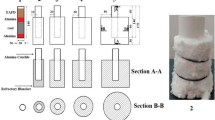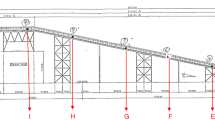Abstract
Weathering of coal and other cellulosic dusts occur due to the process of wetting and subsequent drying, or by subjecting them to a temperature higher than the ambient temperature for prolonged time periods. The first type of weathering occurs in a wetted storage. The second type of weathering occurs when a dust processing unit stores and maintains the dust deposit at an elevated temperature. As a result of weathering, the physical and thermal properties of the dust may change. Therefore, the weathered dust sample is expected to ignite at a different hot plate temperature as compared to that of a fresh sample, when tested in a standard test method (ASTM E 2021). In this study, three dust samples namely, wheat flour, Pittsburgh seam coal and powder river basin coal, are tested. These dust samples are subjected to one or both types of weathering. Thermogravimetric analysis and standard ignition tests are carried out with both fresh and weathered dust samples. Estimation of the activation energies and reactivity, and measurement of the minimum surface temperature for the onset of ignition have been carried out for all the cases. The implications of the observed results on industrial safety related to combustible dust layers are discussed.





Similar content being viewed by others
Abbreviations
- α:
-
Conversion degree
- β:
-
Heating rate (K/s)
- A :
-
Pre-exponential factor (1/s)
- E a :
-
Activation energy (kJ/mol)
- M :
-
Mass (kg)
- m 0 :
-
Initial mass (kg)
- m ∞ :
-
Final mass (kg)
- n :
-
Reaction order
- Q:
-
Heat of combustion (kJ)
- R:
-
Gas constant = 8.314 J/mol-K
- T:
-
Temperature (K)
- t:
-
Time (s)
- f(α) :
-
Kinetic model reaction function
- g(α) :
-
Integral of the kinetic model reaction function
- p(α) :
-
Exponential integral
- PRB:
-
Powder river basin coal
- PSC:
-
Pittsburgh seam coal
References
Nelson CR (1989) Chemistry of coal weathering. Coal Science and Technology, vol 14. Elsevier, Amsterdam
Chen X (1994) The effect of drying heat and moisture content on the maximum temperature rise during self-ignition of a moist coal pile. Coal Prep 14:223–236
Casal M, Gil M, Pevida C, Rubiera F, Pis J (2010) Influence of storage time on the quality and combustion behavior of pine woodchips. Energy 35 (7):3066–3071
Mujumdar AS (2007) Handbook of industrial drying. CRC press, Boca Raton
ASTM E 2021 (2001) Standard test method for hot-surface ignition of dust layers
ASTM E 1226 (2005) Standard test method for pressure and rate of pressure rise for combustible dusts
ASTM E 1515 (2007) Standard test method for minimum explosible concentration of combustible dusts
ASTM E 2019 (2007) Standard test method for minimum ignition energy of a dust cloud in air
Eckhoff RK (2003) Dust explosions in the process industries. Gulf professional publishing, Boston
Miron Y, Lazzara CP (1988) Hot surface ignition temperatures of dust layers. Fire Mater 12:115–126
European Standard E 50281 (1999) Electrical apparatus for use in the presence of combustible dust part 2: test methods of determining minimum ignition temperatures
Wu N, Kolb G, Torero JL (2000) The effect of weathering on the flammability of a slick of crude oil on a waterbed. Combust Sci Technol 161:269–308
Ibarra J, Miranda J (1996) Detection of weathering in stockpiled coals by Fourier transform infrared spectroscopy. Vib Spectrosc 10 (2):311–318
Markowa K, Rustschev D (1994) The application of thermal analysis to the study of ignition processes of solid fuels. Thermochim Acta 234:85–94
Pis J, et al. (1996) A study of the self-heating of fresh and oxidized coals by differential thermal analysis. Thermochim Acta 279:93–101
EN 50281 (1999) Electrical apparatus for use in the presence of combustible dust part 2 test methods of determining minimum ignition temperatures
NFPA 654 (2006) Standard for the prevention of fire and dust explosions from the manufacturing, processing, and handling of combustible particulate solids
Joshi KA, Raghavan V, Rangwala AS (2011) An experimental study of coal dust ignition in wedge shaped hot plate configurations. Combust Flame 159 (1):376–384
Park H, Rangwala AS, Dembsey NA (2009) A means to estimate thermal and kinetic parameters of coal dust layer from hot surface ignition tests. J Hazard Mater 168 (1):145–155
Levendi, YA, Joshi K, Khatami R, Sarofim AF (2011) Combustion behavior in air of single particles from three different coal ranks and from sugarcane bagasse. Combust Flame 158 (3):452–465
Leroy V, Cancellieri D, Leoni E, Rossi JL (2010) Kinetic study of forest fuels by TGA: model-free kinetic approach for the prediction of phenomena. Thermochim Acta 497 (1–2):1–6
Kissinger HE (1957) Reaction kinetics in differential thermal analysis. Anal Chem 29 (11):1702–1706
Cancellieri D, Leoni E, Rossi JL (2005) Kinetics of the thermal degradation of Erica arborea by DSC: hybrid kinetic method. Thermochim acta 438 (1–2):41–50
Acknowledgments
The authors (Joshi and Rangwala) would like to thank the National Science Foundation award #0846764 for funding this work under the American Reinvestment and Recovery Act of 2009. The assistance from WPI student Haejun Park for construction of the flat hot plate apparatus is graciously acknowledged. Finally the authors would like to thank Richard Winschel (CONSOL Energy), Evan Granite (DOENETL) and Bob Zalosh (WPI) for providing dust samples for testing.
Author information
Authors and Affiliations
Corresponding author
Rights and permissions
About this article
Cite this article
Joshi, K., Raghavan, V. & Rangwala, A.S. Effect of Weathering of Coal and Organic Dusts on Their Spontaneous Ignition. Fire Technol 49, 843–856 (2013). https://doi.org/10.1007/s10694-012-0292-7
Received:
Accepted:
Published:
Issue Date:
DOI: https://doi.org/10.1007/s10694-012-0292-7




